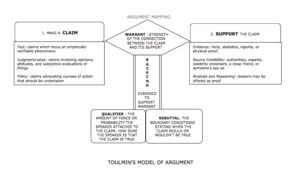So what’s this all about?
Hi fellow readers and writers!
For my final project in our tutor training class, I chose to research and present the Toulmin argument model. The Toulmin Model is an organizational model that breaks written argument into three separate stages: claim, evidence, and analysis.
I chose this method because I find myself frequently referring to it during tutoring appointments. One of the most frequent agenda items we set in the Writing Center is organization; I find that the vast majority of writers need help in either creating or clearly organizing their claims, evidence, and analysis. By doing extra research on the topic and its origins, I sought to reinforce my own understanding and ability to pass the information along, as well as provide resources for my fellow tutors.
Okay, so what did you find out and how?
Glad you asked! Here are the most important definitions:
Claim is the sentence (or two) that asserts a point that the author is arguing as true.
Evidence (aka Data or Reasoning) is the outside data or facts that the author references to support their claim.
Analysis (aka Warrant) is a series of sentences that connect the evidence to the claim. The analysis answers the questions: “why/how does the evidence support the claim?” and “what is the overall significance of the claim and the evidence in the larger argument?”
In my research, I explored Toulmin’s original text, two scholarly texts (1,2) produced from original research by teachers, and one blog post made by a teacher that described his method for teaching the Toulmin Method to students. I also read many other teacher-produced webpages as resources for how teachers across grade levels and subjects apply the claim-evidence-analysis method within the classroom.
Nice, but what does that have to do with the UCWbL? How can I apply this to tutoring?
Another great question. Across the board, research concluded that teaching students–in our case, writers–the definitions of claim, evidence, and analysis, followed by practice utilizing the concepts in writing, led to an overall improvement in the quality of their written arguments. I think this seems pretty believable and self-explanatory; the model itself is basically a walkthrough on how to articulate a strong argument in written form.
Ultimately, I think Toulmin’s model is helpful for every tutor because it inherently provides a checklist for the most essential elements of an argument. When a writer approaches me with a piece of writing that has the capacity for organizational improvement (which, I would argue, applies to 99% of written works), finding which piece a writer is missing is the first step in improving their argument. Similarly, claims, evidence, and analysis may all be present, and the question may be figuring out which element needs improvement or expansion.
The best way to apply this is literally to underline/highlight/demarcate in some form each element of Toulmin’s argument model. This will allow you and the writer to see whether the pieces need to be reorganized, clarified, or whether they are present at all.
Then, I’ve found that asking questions is the best way to proceed. For claims, the questions will address purpose and intention: What is the point of this paragraph? What do you want your audience to know/believe/understand by the time they’ve finished reading this paragraph? What part of your thesis are you arguing in this paragraph?
For evidence, the questions will address the sources or data the writer has provided. “How do you know this? Where did/can you find this information? What empirical data/facts exist that you could draw upon to back up your claim?”
Finally, analysis questions are the heavy hitters. The bulk of the logos is established in this section, so it should be strong. “What does the evidence mean? How is it related to the claim? How is that claim related to your thesis/overall argument? Why is it important that you have this paragraph/what does it prove?”
Any cool graphics or handy guides for us, Marina?
Oh reader, you already know what it is.
Go forth and tutor with confidence!
Discover more from UCWbLing
Subscribe to get the latest posts sent to your email.

